Abstract
Body donation is the act of giving one’s body to science for study, practice, and research. This selfless act contributed to the education and training of professionals in the field of medicine. Body donation programs allow medical students to learn about the different aspects of human anatomy, perfect their dissection skills, and develop a better understanding of the relationship between structure and function in the human body. The purpose of article is to improve body donation programs which meet ethical standards and best practices. This article emphasizes the significance of body donation to teaching medical institutions by discussing various aspects of body donation to medical colleges in India and the procedural steps followed, sample proformas and the obstacles faced during the whole process. The process of body donation varies among different countries pertaining to their legal frameworks and the challenges faced. A description of the problems faced in the process of body donation has been discussed with suggestions for potential solutions in this section. The sample formats of the forms filled by donors and the certificates issued by concerned organizations are also provided to clearly understand the process of body donation. The information compiled will pave the way for medical teaching institutions that have yet to start a body donation program.
Body donation is the act of giving one’s body to science for study, practice, and research. There is an increasing demand for donated bodies in medical research and education. Although it has been done for centuries, the practice of body donation is becoming more common. The dissection of criminals in Alexandria, Egypt, around the third century B.C. represents the earliest instance of body donation that is known. This marked the start of the practice of body donation for academic study [1-3]. The father of modern human anatomy, Andreas Vesalius started the dissections on bodies of executed criminals to ensure the adequate supply of human bodies by the mid of 16th century [4]. Body donation was not popular and acceptable in Western culture until the 19th century. The UK’s 1832 passage of the Anatomy Act made it permissible to purchase bodies for use in medical study and training. Body donation has significantly improved healthcare and increased medical knowledge [5]. Body donation programs allow medical students to learn about the different aspects of human anatomy, perfect their dissection skills, and develop a better understanding of the relationship between structures and relations in the human body [6-8]. Therefore, many countries have developed body donation programs, including India, the United States, Canada, and the United Kingdom. However, there have also been variances in regard to body donation, particularly in terms of ethical issues and how the bodies are handled [5, 9-11].
Previous research articles have also highlighted the importance of body donation in advancing medical education and research in India [12-15]. The availability of bodies for dissection and research is crucial for the training of medical students and healthcare workers [16-18]. A key part of medical education for a long time has been body donation. Donated bodies provide in situ learning experiences of the human body, which is crucial in preparing students for applied medicine. According to research by Hafferty [19], cadavers are used for anatomical instruction in most US medical schools. Researchers from a wide range of fields, including anthropology, biomechanics, and engineering, use donated bodies to study the mechanics and function of human motion [7]. The development of medical research is one of the most important advantages of body donation. Donated bodies are used by medical researchers and students to study human anatomy and physiology, which results in the development of procedures and technologies for life savings [16, 20]. Medical professionals need to learn and practice advanced techniques on actual human bodies to obtain expertise before bringing in actual practice. Medical school postgraduate students and professionals receive training on donated bodies, giving them experience about the complexity of any procedure [5, 15, 21]. All over India, hands-on training workshops and continuing medical education programs are conducted in collaboration with the anatomy department. The postgraduate students from anesthesia, surgery, orthopedics and ear, nose, throat, or otolaryngology departments perform procedures on cadavers before directly dealing with the patients.
Furthermore, body donation is helpful to forensic research. Body donation to forensic science can aid in the investigation of crimes, the identification of catastrophe victims, and the training of forensic experts [6, 15, 22]. Forensic scientists use donated human remains to develop new techniques and technologies that lead to more convictions and justice for victims while sharpening the focus of forensic investigations [6, 22]. By donating their bodies, people may uphold their own personal principles and convictions. Body donation is supported by several faiths as a benevolent and selfless act. By donating one’s body to science, one may both live out their values and have a lasting good impact on the world that will continue for endless years.
The donation process involves several steps, including registration, screening, and acceptance. Some documents are required to donate a body, such as written informed consent, an identification card or certificate from the body donation organization, a government-approved identity card, a death certificate, and a transit permit or permission letter from the local government.
The Bombay Act of 1949 established the legal foundation for body donation in India [23]. The Bombay Act was first constituted in Mumbai of Maharashtra State, India [13, 24]. The laws governing the donation of bodies for use in medical research and educational purposes are outlined in this legislation. This law stipulates that to donate a body, written authorization from the donor or their heirs is needed. Consent must state the reason for the body’s donation and must be granted in the presence of two witnesses.
Government Medical College and Hospital (GMCH) is located in Union Territory of India & successfully runs the body donation program for medical education & research. The process followed is shown in Fig. 1.
The first step starts with registration. Prospective donors may register with a body donation program and complete a screening process to determine if they meet the program’s eligibility conditions. The donor’s body is used for medical research or educational purposes after being accepted. In India, there are several organizations, including medical colleges, that facilitate body donation for medical research and education. These organizations play a crucial role in the process of body donation by providing guidance and assistance to donors and their families. They also ensure that the bodies are used for legitimate purposes and are not misused for any illegal activities [16, 25].
The prospective donors are provided with a registration form named ‘WILL’ (Fig. 2) to be filled in in the presence of two witnesses. This form also bears the organization’s contact numbers for body donation.
In case the person has not been registered and has expressed his/her will to donate at the time of death or if the family wants to donate the body of the deceased, family members can contact the concerned department and complete the application form to donate the body (Fig. 3) and consent form (Fig. 4). The donor or their next of kin (NOK) must provide certain information, such as name, age, address, and contact details, to register with a body donation organization.
The organization provides the donor or their NOK with an identity card or certificate, which confirms that the donor has registered for body donation (Fig. 5A, B). The organization also provides guidance on the process of body donation, including the procedure of information at the time of death, transporting the body to the medical institution and the documents required at that time for the same.
According to the Bombay Act of 1949, the transportation of a body for medical research or education must be carried out in accordance with the rules and regulations established by the state governments. The body must be transported in a sealed coffin or box that bears the name of the donor, the date and time of death, and the cause of death. The coffin or box must also be accompanied by a death certificate and a certificate from the medical institution where the body is to be donated [26].
In addition to the documentation indicated above, the transport of the body may also require a transit permit or a permission letter from the local authorities. The transit permit is a document that authorizes the transportation of the body from one place to another, while the permission letter is a document that grants permission for the body to be transported through certain areas or routes. The requirements for the transit permit and permission letter may “vary from state to state” and must be checked with the local authorities before transportation. It is also important to remember that certain taxes and fees that are typically applied to transportation are not applied to the transportation of a body for medical research or education. This exemption is provided by the Bombay Act of 1949 and is aimed at encouraging body donation for medical research and education.
As the body is transferred to the medical institution, all documents related to identity, cause of death and identity proofs of kins are verified and collected for record keeping. The list of documents collected is as follows:
1. Donor card (if already registered)/application for body donation.
2. Death certificate/death summary.
3. Government approved identity card of the deceased.
4. Two-passport photographs of the deceased.
5. Government approved identity card of NOK with contact number.
To express gratitude to the family members and to promote this selfless act of body donation, the institutes issue the certificate of appreciation in the name of the donor (Fig. 6). Moreover, in some places, the department head/faculty pays thanks for visiting the family members and ensures that the bodies are handled with utmost respect and care. The department also acknowledges the donors by displaying their pictures in the department (after taking approval from the donor/family).
Afterwards, the donated body undergoes the procedure of embalming and preservation, which ensures that the body can be used for medical study and education for an extended period.
Researchers and body donors have emphasized the necessity of ethics and transparency in the body donation process. The need for clear regulations and policies arose to guarantee that the bodies are used for proper purposes and are not misappropriated for any illegal activities [10, 27]. Ethics-related concerns, including informed consent, respect for the body, and privacy, are raised by body donors. Throughout the donation procedure, the body must be handled delicately, and donor informed consent must have been acquired. The majority of body donors have philanthropic motives and want to improve medical knowledge, the benefits and uses of body donation, and how it affects ethical concerns and medical research and teaching.
Informed consent is an essential ethical factor in body donation is informed consent. Before they pledge for donation, the donors must be fully aware of the purpose of the gift, how their bodies will be used, and any risks. Informed consent for body donation is a subject that has been covered in a number of studies. A study by Viljoen and Stephens [28] revealed that donors understood the donation process well and were generally happy with the informed consent procedure. The study did uncover the need for more comprehensive information on the donation procedure, as well as the fact that some donors had irrational expectations about how their bodies would be utilized. Another study discovered that the standard of informed consent varied greatly among various body donation programs [29]. This research advised the creation of standard guidelines for obtaining informed consent to ensure that donors are properly informed and that the procedure is uniform across various programs.
Another fundamental ethical principle in the donation of human bodies is respect for the dignity of the person donating the body. Throughout the donation procedure, donors must be respected, and their bodies must be handled with care. This involves preventing needless injury or deformity to their bodies, treating their remains with respect and disposing of their remains properly. The topic of respecting the donor’s dignity in body donation has been covered in a number of studies. For instance, Dluzen et al. [30] discovered that donors were usually pleased with the degree of respect offered to their bodies throughout the donation procedure [31]. The research discovered that some donors were worried about the possibility of their bodies being utilized in ways they felt undesirable. Donors will be more inclined to give their bodies for donation if they believe the procedure will be polite and their remains will be handled with dignity. Other than this, the donors have the right to maintain the confidentiality of their personal information and to remain anonymous if they want. They must also be protected from revealing their identities to ‘unauthorized parties’ and from having their personal information accessed or used without their consent. The majority of donors preferred to remain anonymous, and their personal information was kept private as per their wish [28]. Hutchinson et al. [9] found that family members who were making decisions about body donation on behalf of the deceased prioritized confidentiality as a top concern. The study suggested that programs for body donation should be open about their policies regarding confidentiality and make sure that the privacy of donors and their families is protected.
When using donated bodies for research, researchers have a duty to uphold ethical standards. This includes confirming that research is conducted in a manner that respects the rights and dignity of donors and that any risks to donors or their families are minimized. Several studies have addressed the issue of research ethics in body donation. Donors were found to be generally supportive of the use of their bodies for medical education and research; however, they were concerned about the potential for their bodies to be used in objectionable ways [32]. The study recommended that researchers should be very transparent about their research goals and methods. Ghosh [18] stated that programs for body donation should have clear policies on the ‘kinds of research’ that are permitted and the ethical standards that must be maintained. The study also recommended that researchers follow the established ethical guidelines when using donated bodies for research purposes.
Programs for body donation must ensure that donors are not under any kind of pressure to donate their bodies [32, 33]. Previous studies have examined the problem of finding donors for body donations. Some body donation programs may use improper recruiting techniques, such as newspaper or internet advertising, which might result in unsuitable donor expectations and pressure to donate [34]. Body donation programs only find donors through legitimate sources and provide them with accurate information about the donation procedure, including any potential advantages and disadvantages [13]. Family members should be given clear and accurate information about the donation process and the intended use of the body before they make decisions regarding body donation on behalf of deceased loved ones [35].
Despite knowing the importance of body donation, there are still several hurdles that individuals and organizations face when attempting to donate their bodies to science. One of the most common factors is lack of awareness leading to India’s low body donation rates. It is challenging to persuade people to give their bodies for medical research and education in many areas of India since there is a small number of people who know about the existence of body donation after death, while a large number have a strong idea that the body should be burnt or buried traditionally after death [21]. More awareness campaigns and educational initiatives that facilitate the significance of body donation in promoting medical research and teaching are required to overcome these issues. Governments and non-governmental groups may be extremely helpful in educating donors and their families and offering counseling [34, 36]. Although the information for prospective donors is provided on our institute’s website but it doesn’t seem sufficient to raise awareness. Our department organizes the poster-making competition for medical students and displays the posters on the corridors of hospital attached with college. Thus, posters with slogans are available for hospital visitors, patients and relatives.
Legal concerns present a significant barrier to body donation. The related laws and ethical standards can lack clarity to the donor and their family. The regions where the processing of donated bodies may not be governed by specific state regulations might cause confusion and slow down the donation process. Some people could object to the use of their bodies by a particular organization or for particular types of study [20]. The Anatomy department at GMCH has outlined the clauses of body donation act to keep the readily available for prospective donors, so that they could be assured of their safeguards by legal framework.
Body donation may also be hampered by cultural and religious beliefs. Due to religious or cultural convictions, some people may be against body donation because they believe it to be sacrilegious or improper. Some traditional methods based on religion require the body to be buried whole, which may make body donation impossible [35, 36]. To run a program for whole body donation, take into account the cultural and religious beliefs of potential donors and their families [36, 37]. This might entail establishing standards for body donation that are in keeping with religious views by collaborating with religious bodies or leaders. Institute/organization must ensure the bodies are handled with respect.
Another major barrier to body donation at some places might be a lack of resources, particularly finances and staff. Sometimes lack the embalming facilities or trained staff for performing the embalming procedure. Even after embalming, storage is the next major hurdle. The lack of cooling chambers or formalin tanks to store for longer durations can restrict the institutions for receiving bodies. Sometimes, medical institutions and other entities lack the resources necessary to handle and utilize donated bodies in an effective manner [31]. It is crucial to have the tools required to handle donated bodies well. Additionally, it can entail establishing cooperative agreements for the pooling of resources with healthcare organizations and other partners. GMCH is a tertiary care hospital with medical teaching and training. The faculty and staff here is well trained and ensure the proper preservation of cadavers, cleaning of the formalin tanks and temperature maintenance of cooling chambers for storage.
The logistics and transportation of body donation might sometimes be quite difficult. Transporting the body may be challenging in some situations due to the great distance between the donor’s location and the hospital or research center. Additionally, handling and storage of a body during transportation can be complicated and require expert staff and equipment [37]. Creating specialist services for the transfer of donated bodies may entail collaborating with transportation firms or other partners. To guarantee that donated bodies are transported securely and successfully, it may also entail developing procedures and rules for their management and storage [23]. Most of teaching hospitals including ours provide free transportation of donated bodies which is available on request of family members.
Despite of having challenges in running whole body donation programs, the outcome is always valuable to keep the standards of anatomical education high especially for the medical graduates. Body donation is way forward for medical education. Lastly, the limitation of this study is that it is providing the sample proformas of single institute where the body donation program is being run. In future, it may include the multiple institutes too to conduct and participate in providing details of body donation program on a questionnaire-based data. Some suggestions of questions for further studies are given below:
1. How many donated bodies an academic institution is receiving each year?
2. Is there adequate infrastructure for reception, embalming and storage of bodies?
3. Is there availability of trained staff for respectfully handling the bodies?
4. What are the main obstacles faced in successfully running body donation program?
In conclusion, there is a need for ongoing evaluation and improvement of body donation programs to ensure that they continue to meet ethical standards and best practices. Overall, body donation programs play a critical role in advancing medical education and research, but it is important that they are conducted ethically and with the utmost respect for donors and their families. By adopting recognized ethical standards and best practices, body donation programs can ensure that the donation process is transparent, informed, and courteous and that it contributes to the greater good of society.
Acknowledgements
The authors sincerely thank those who donated their bodies to science so that anatomical research and teaching could be performed. The results from such research can potentially increase scientific knowledge and can improve patient care. Therefore, these donors and their families deserve our highest respect.
Notes
References
1. Elhadi AM, Kalb S, Perez-Orribo L, Little AS, Spetzler RF, Preul MC. 2012; The journey of discovering skull base anatomy in ancient Egypt and the special influence of Alexandria. Neurosurg Focus. 33:E2. DOI: 10.3171/2012.6.FOCUS12128. PMID: 22853833.

2. Riederer BM. 2016; Body donations today and tomorrow: what is best practice and why? Clin Anat. 29:11–8. DOI: 10.1002/ca.22641. PMID: 26475613.

3. Bennett RE. Bennett RE, editor. A fate worse than death? Dissection and the criminal corpse. Capital punishment and the criminal corpse in Scotland, 1740-1834. Palgrave Macmillan;2017. p. 159–85. DOI: 10.1002/ca.22641.
4. Ghosh SK. 2015; Human cadaveric dissection: a historical account from ancient Greece to the modern era. Anat Cell Biol. 48:153–69. DOI: 10.5115/acb.2015.48.3.153. PMID: 26417475. PMCID: PMC4582158.

5. Park HJ, Ahn H, Ki E, Lee JS, Choi Y, Hu KS, Chun YM, Kim HJ. 2021; Body donation trends in Yonsei University: a statistical analysis of donor records. Anat Cell Biol. 54:59–64. DOI: 10.5115/acb.20.261. PMID: 33424016. PMCID: PMC8017449.

6. Richardson JD. 2002; Workforce and lifestyle issues in general surgery training and practice. Arch Surg. 137:515–20. DOI: 10.1001/archsurg.137.5.515. PMID: 11982462.

7. Bertolo R, Garisto J, Dagenais J, Sagalovich D, Kaouk JH. 2018; Single session of robotic human cadaver training: the immediate impact on urology residents in a teaching hospital. J Laparoendosc Adv Surg Tech A. 28:1157–62. DOI: 10.1089/lap.2018.0109. PMID: 29708828.

8. da Rocha AO, Tormes DA, Lehmann N, Schwab RS, Canto RT. 2013; The body donation program at the Federal University of Health Sciences of Porto Alegre: a successful experience in Brazil. Anat Sci Educ. 6:199–204. DOI: 10.1002/ase.1335. PMID: 23184541.

9. Hutchinson EF, Kramer B, Billings BK, Brits DM, Pather N. 2020; The law, ethics and body donation: a tale of two bequeathal programs. Anat Sci Educ. 13:512–9. DOI: 10.1002/ase.1922. PMID: 31596033.

10. Winkelmann A. 2016; Consent and consensus-ethical perspectives on obtaining bodies for anatomical dissection. Clin Anat. 29:70–7. DOI: 10.1002/ca.22651. PMID: 26475682.

11. Habicht JL, Kiessling C, Winkelmann A. 2018; Bodies for anatomy education in medical schools: an overview of the sources of cadavers worldwide. Acad Med. 93:1293–300. DOI: 10.1097/ACM.0000000000002227. PMID: 29561275. PMCID: PMC6112846.

13. Rokade SA, Gaikawad AP. 2012; Body donation in India: social awareness, willingness, and associated factors. Anat Sci Educ. 5:83–9. DOI: 10.1002/ase.1263. PMID: 22278885.

14. Aneja PS, Bansal S, Sood KS, Saxena A. 2013; Body donation--a dilemma among doctors. J Evol Med Dent Sci. 2:2585–93. DOI: 10.14260/jemds/582.
15. Ahmed K, Rowland S, Patel V, Khan RS, Ashrafian H, Davies DC, Darzi A, Athanasiou T, Paraskeva PA. 2010; Is the structure of anatomy curriculum adequate for safe medical practice? Surgeon. 8:318–24. DOI: 10.1016/j.surge.2010.06.005. PMID: 20950770.

16. Rokade SA, Bahetee BH. 2013; Body donation in India: a review. Int J Res Med Sci. 1:173–7. DOI: 10.5455/2320-6012.ijrms20130814.

17. Kim DH, Shin DH, Hwang YI. 2019; Effects of alternate dissection on anatomy learning. Anat Cell Biol. 52:69–75. DOI: 10.5115/acb.2019.52.1.69. PMID: 30984454. PMCID: PMC6449586.

18. Ghosh SK. 2020; The practice of ethics in the context of human dissection: setting standards for future physicians. Ann Anat. 232:151577. DOI: 10.1016/j.aanat.2020.151577. PMID: 32688021. PMCID: PMC7366954.

19. Hafferty FW. 1988; Cadaver stories and the emotional socialization of medical students. J Health Soc Behav. 29:344–56. DOI: 10.2307/2136868. PMID: 3253325.

20. Agthong S, Wiwanitkit V. 2002; Cadaver donation: a retrospective review at the King Chulalongkorn Memorial Hospital, Bangkok. Southeast Asian J Trop Med Public Health. 33 Suppl 3:166–7. PMID: 12971502.
21. Bunprasert T. 1998; The new potential of surgical training: surgical training center. Chulalongkorn Med J. 42:413–5. DOI: 10.56808/2673-060X.3856.

22. Christensen AM. 2006; Moral considerations in body donation for scientific research: a unique look at the University of Tennessee's anthropological research facility. Bioethics. 20:136–45. DOI: 10.1111/j.1467-8519.2006.00487.x. PMID: 17039632.

23. Government of Maharashtra. 1949. Bombay Act No. XI of 1949. The Maharashtra Anatomy Act (as modified up to the 13th January 2014) [Internet]. Government of Maharashtra;Available from: https://bombayhighcourt.nic.in/libweb/acts/1949.11.pdf. cited 2023 Apr 19.
24. Bharambe V, Puranam V, Manvikar PR, Bajpayee P. 2019; Anatomy acts in India: a review. Eur J Anat. 23:469–77.
25. Gulielmi IV. 1832. Regis. The Anatomy Act 1832 [Internet]. The National Archives;Available from: https://www.nationalarchives.gov.uk/education/resources/body-snatchers/source-four-the-anatomy-act-1832/. cited 2023 Apr 19.
26. Saha A, Sarkar A, Mandal S. 2015; Body donation after death: the mental setup of educated people. J Clin Diagn Res. 9:AC05–9. DOI: 10.7860/JCDR/2015/12246.6011. PMID: 26266106. PMCID: PMC4525495.

27. Comer AR. 2022; The evolving ethics of anatomy: dissecting an unethical past in order to prepare for a future of ethical anatomical practice. Anat Rec (Hoboken). 305:818–26. DOI: 10.1002/ar.24868. PMID: 35244981.

28. Viljoen JK, Stephens S. 2021; Assessing the perceptions of individuals with differing levels and backgrounds of education towards whole-body donation. Ann Anat. 233:151604. DOI: 10.1016/j.aanat.2020.151604. PMID: 32979528.

29. Sasi A, Hegde R, Dayal S, Vaz M. 2020; 'Life after death - the dead shall teach the living': a qualitative study on the motivations and expectations of body donors, their families, and religious scholars in the South Indian city of Bangalore. Asian Bioeth Rev. 12:149–72. DOI: 10.1007/s41649-020-00117-3. PMID: 33717335. PMCID: PMC7747233.

30. Dluzen DE, Brammer CM, Bernard JC, Keyser ML. 1996; Survey of cadaveric donors to a body donation program: 1978-1993. Clin Anat. 9:183–92. DOI: 10.1002/(SICI)1098-2353(1996)9:3<183::AID-CA10>3.0.CO;2-N. PMID: 8740481.

31. Gunderman RB. 2008; Giving ourselves: the ethics of anatomical donation. Anat Sci Educ. 1:217–9. DOI: 10.1002/ase.39. PMID: 19177414.

32. Jones DG. Sisu AM, editor. Human anatomy: a review of the science, ethics and culture of a discipline in transition. Human anatomy - reviews and medical advances. IntechOpen;2017. DOI: 10.5772/intechopen.68524.
33. Lauri MA. 2006; Attitudes towards organ donation in Malta in the last decade. Malta Med J. 18:25–9.
34. Federative International Committee for Ethics in the Medical Humanities. 2012. Recommendations of good practice for the donation and study of human bodies and tissues for anatomical examination [Internet]. International Federation of Associations of Anatomists;Available from: https://ifaa.net/wp-content/uploads/2017/09/IFAA-guidelines-220811.pdf. cited 2023 Apr 19.
35. Ballala K, Shetty A, Malpe SB. 2011; Knowledge, attitude, and practices regarding whole body donation among medical professionals in a hospital in India. Anat Sci Educ. 4:142–50. DOI: 10.1002/ase.220. PMID: 21548060.

36. Boulware LE, Ratner LE, Sosa JA, Cooper LA, LaVeist TA, Powe NR. 2002; Determinants of willingness to donate living related and cadaveric organs: identifying opportunities for intervention. Transplantation. 73:1683–91. DOI: 10.1097/00007890-200205270-00029. PMID: 12042662.

37. Appaji AC, Kulkarni R. 2012; A survey on the role and the status of cadavers in medical education: an Indian scenario. J Clin Diagn Res. 6:1132–6.




 PDF
PDF Citation
Citation Print
Print



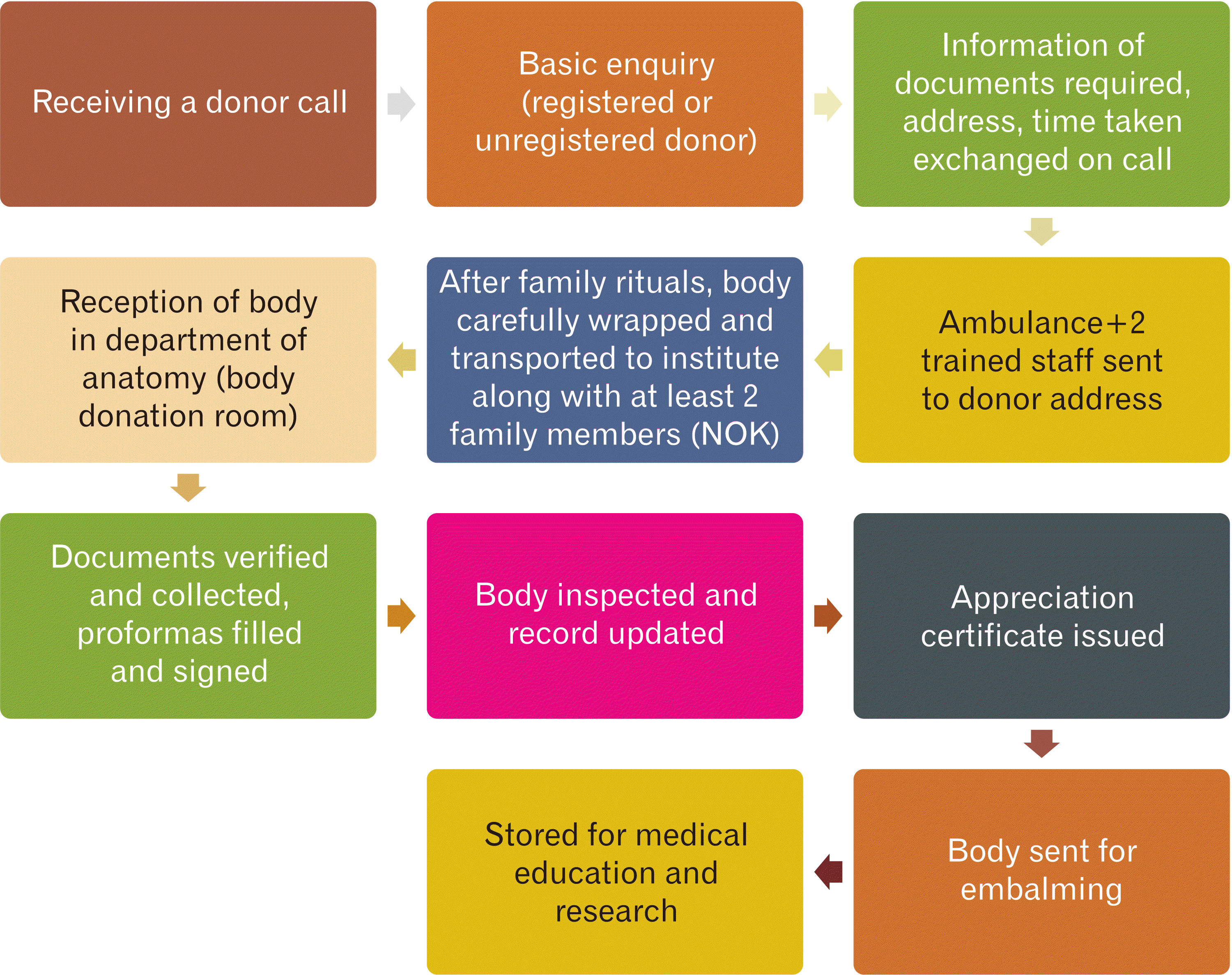
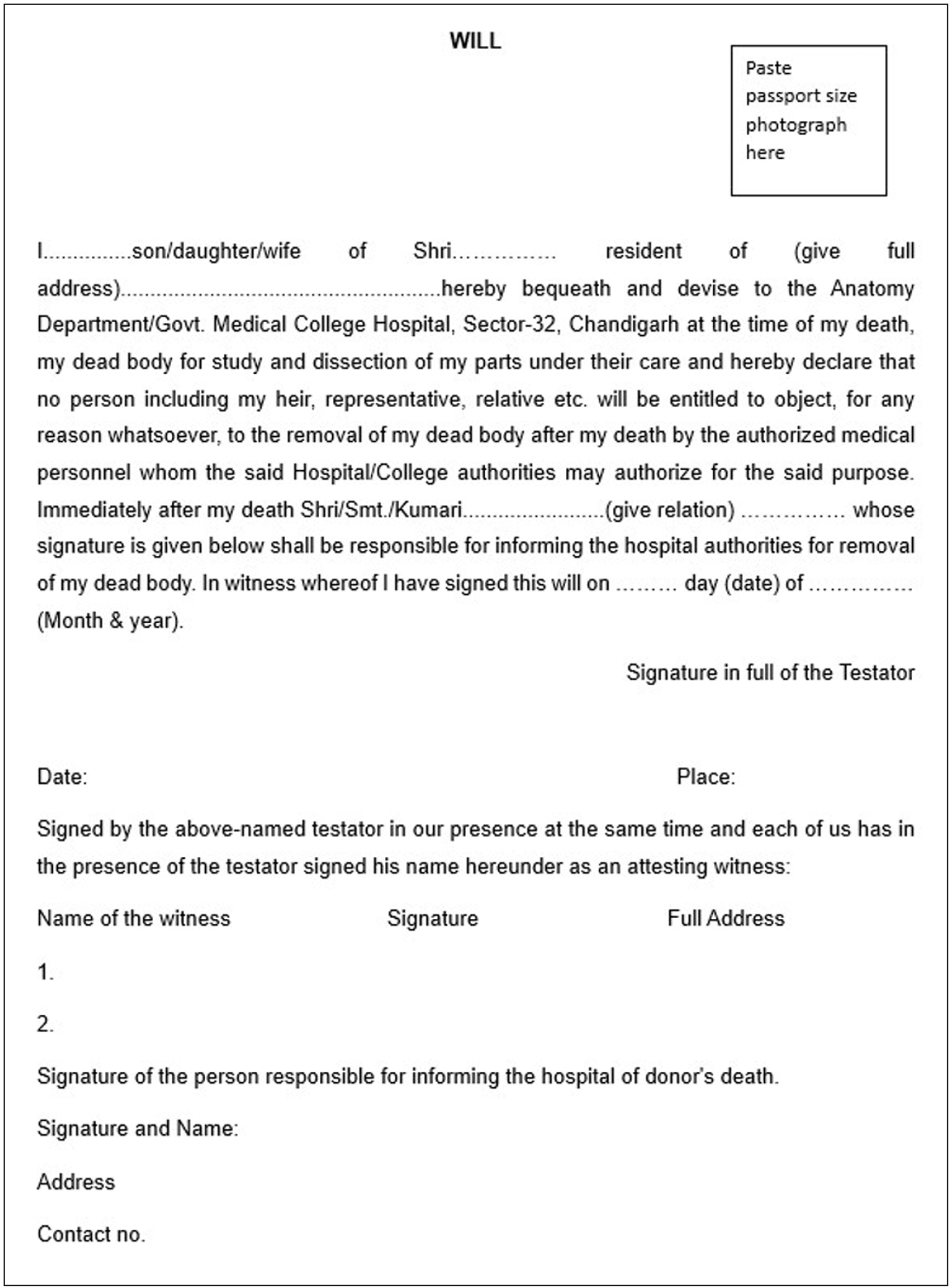
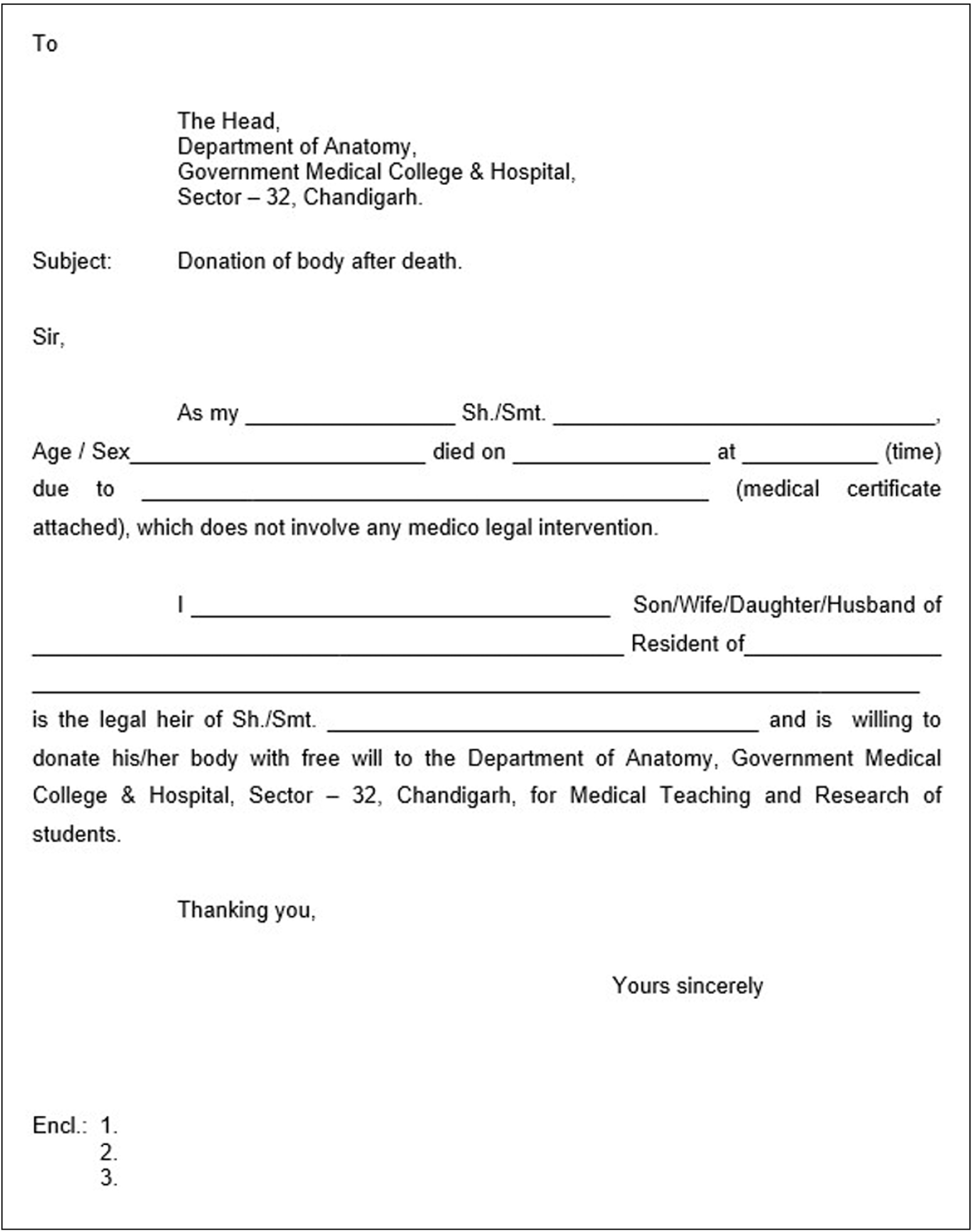
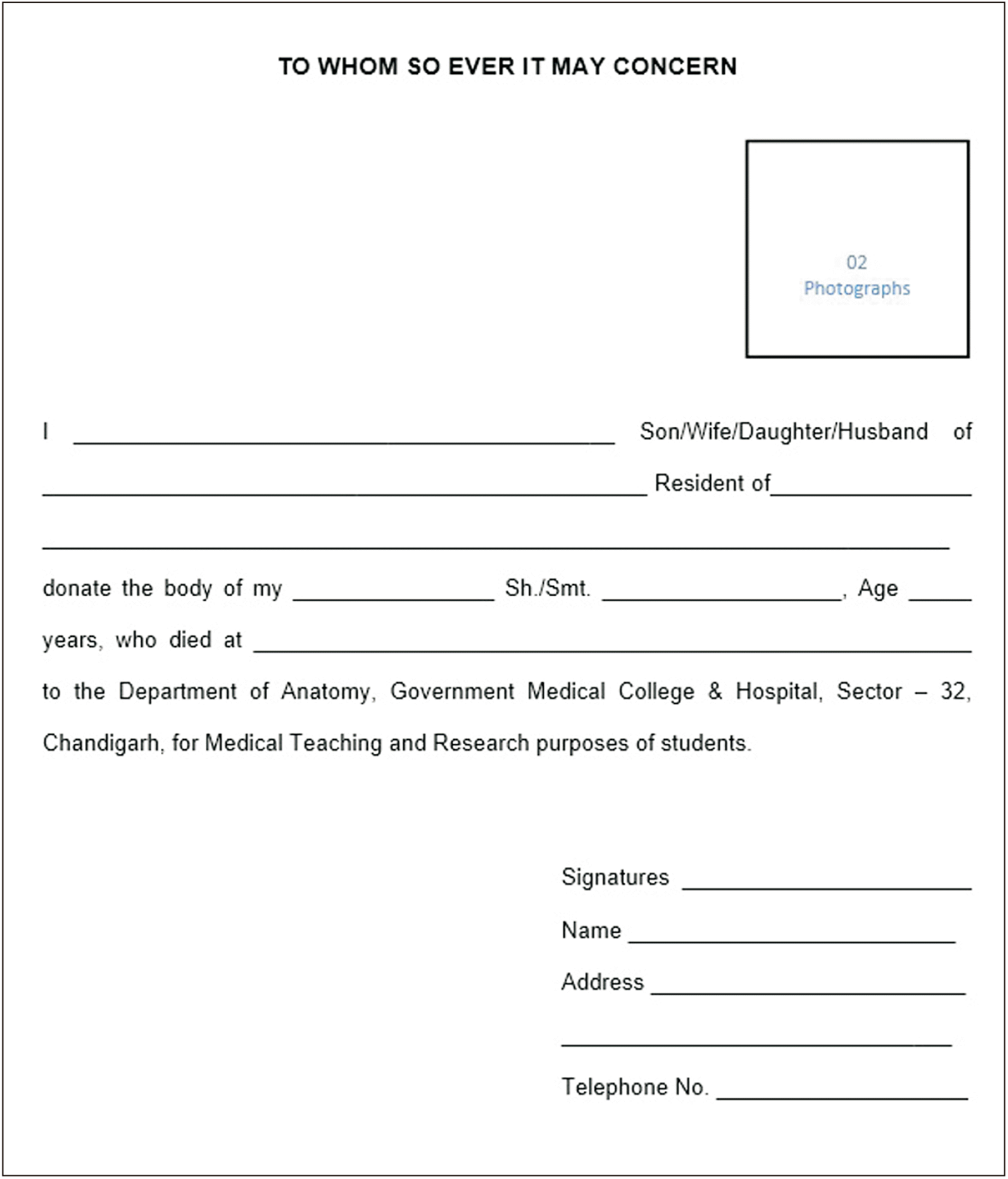

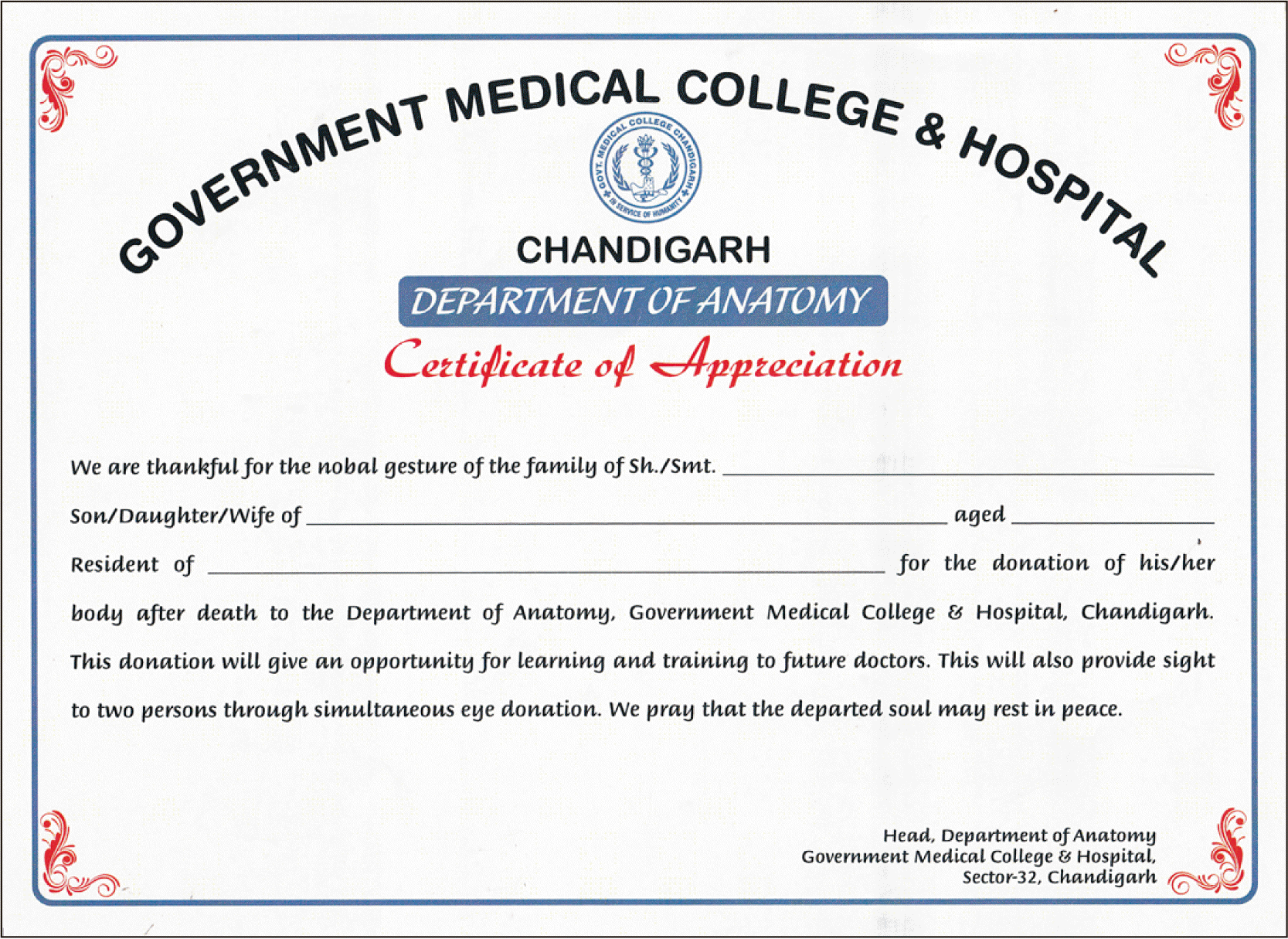
 XML Download
XML Download